Golden Gate Ferry Timeline
1967: Concern over increasing traffic congestion on the Golden Gate Bridge triggered the San Francisco Board of Supervisors to ask the Golden Gate Bridge and Highway District (GGBHD) Board of Directors to explore the idea for ferry service between San Francisco and Marin County.
July 1969: Arthur D. Little, Inc., prepared a report, Feasibility Study of San Francisco-Marin Ferry System, funded by Marin County Transit District and the City and County of San Francisco, indicating that a ferry system was feasible and should be implemented and operated by the GGBHD.
November 10, 1969: Assembly Bill 584 authorized the GGBHD to develop a transportation facility plan to implement a mass transportation program in the U.S. Highway 101/Golden Gate Corridor and the agency’s name was changed to Golden Gate Bridge, Highway and Transportation District (District).
January 12, 1970: The District contracted Philip F. Spaulding and Associates, Seattle, WA, to design a commuter ferry system between Marin and San Francisco. They released their report, Golden Gate Commuter Ferry Boat System, to the District Board of Directors on August 1, 1970. Read several excerpts from the report.
Saturday, August 15, 1970: Golden Gate Sausalito Ferry service began.
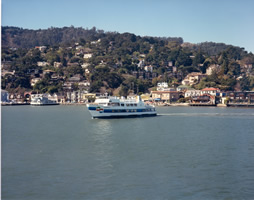 The original M.V. Golden Gate departing Sausalito
The original M.V. Golden Gate departing Sausalito
February 1972: The District purchased a 25-acre site in Larkspur, CA for a future ferry terminal.
August 1972: Campbell Industries of San Diego, CA, is awarded a contract to construct three Spaulding Class ferry vessels for use on a second ferry route between Larkspur and San Francisco. Vessel construction began later that year.
October 1973: Golden Gate Ferry entered into a long-term lease with the San Francisco Port Commission for the use of the San Francisco Golden Gate Ferry Terminal location.
September 1974: Williams & Burrows, Inc. was awarded a contract to build the Golden Gate Larkspur Ferry Terminal.
October 1, 1974: U.S. Army Corp of Engineers authorized Golden Gate Ferry to undertake necessary dredging in Corte Madera Creek in preparation for ferry operations.
May 22, 1976: The G.T. Sonoma was christened at Campbell Industries, San Diego, CA.
Saturday, December 11, 1976: The Golden Gate Larkspur Ferry Terminal was dedicated and the first Spaulding Class vessel was placed into service as the G.T. Marin. Over the opening weekend, 6,100 passengers plied the San Francisco Bay aboard Golden Gate Larkspur Ferry. See special GGF ticket from first day of service for the G.T. Marin.
Monday, December 13, 1976: Commute service commenced on the Larkspur route.
March 7, 1977: The second Spaulding Class vessel, G.T. Sonoma, entered into service on the Larkspur route.
April 1977: Construction began on the Golden Gate San Francisco Ferry Terminal.
September 12, 1977: The third Spaulding Class vessel - the G.T. San Francisco - was delivered to Larkspur. With this third Spaulding vessel, Larkspur Ferry operated service using two vessels, with the third as back up.
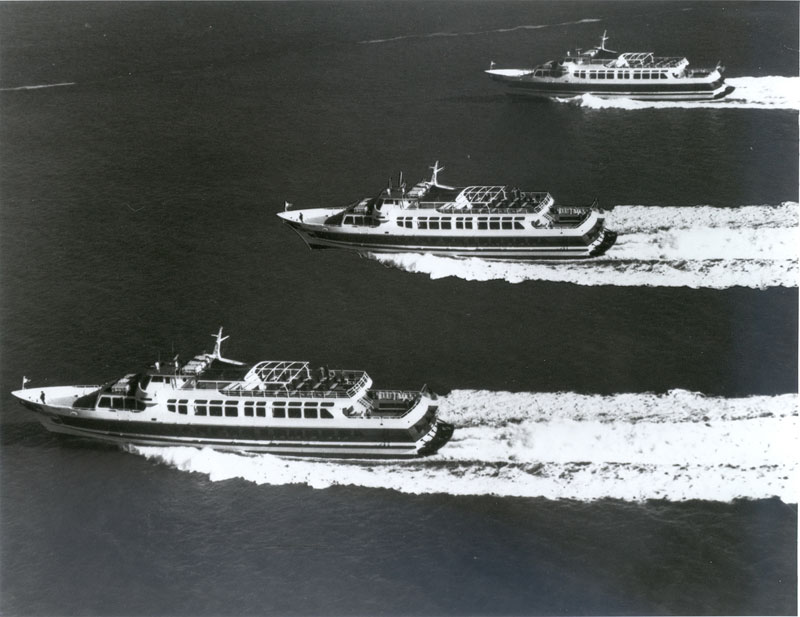 The 3 Spaulding vessels
The 3 Spaulding vessels
December 11, 1977: The one year anniversary of Golden Gate Larkspur Ferry. During this first year of operation, 1,183,781 passengers were served.
June 17, 1978: The San Francisco Golden Gate Ferry Terminal was dedicated. Located behind the San Francisco Ferry Building at the foot of Market Street along the Embarcadero, the terminal was rededicated as the Stephan C. Leonoudakis San Francisco Ferry Terminal in honor of a retired District Board member on August, 24, 2001. Leonoudakis was appointed to the Board of Directors in 1962 and was a key leader in the development of ferry service in the early 1970s.
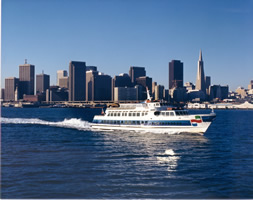 After departing the new San Francisco Terminal!
After departing the new San Francisco Terminal!
April 18, 1979: The first annual commemorative 1906 earthquake ferry ride was offered to survivors of the 1906 San Francisco Earthquake and Fire. This special event service ran annually until 2005.
January 4 to 7, 1982: After days of constant rain, mud slides closed Highway 101 from the evening of January 4 through the evening of January 6. Larkspur Ferry carried a record number of commuters, reaching a high of 12,028 on January 6. On January 6 and 7, three additional vessels were chartered to assist with the high passenger demand.
May 19, 1982: Dedication ceremonies took place for the Larkspur Ferry Terminal pedestrian overpass connecting the terminal with the Larkspur Landing shopping center located across Sir Francis Drake Boulevard.
December 1983: Golden Gate Ferry inaugurated the Merry Ferry event which continued annually through 2005, offering onboard holiday surprises during the holiday season. Shuttles to and from San Francisco's Union Square were an added bonus for weary shoppers.
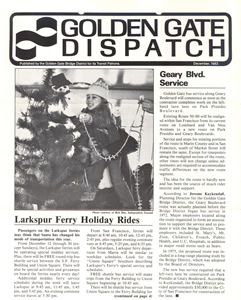
December 12, 1983: The G.T. San Francisco returned to San Diego to undergo conversion from gas turbine propulsion to diesel. By converting to diesel fuel, Golden Gate Ferry was able to reduce fuel costs by 60% and maintenance costs by $300,000 annually.
Spring/Summer/Fall 1984: Golden Gate Ferry's new Lunch for the Office Bunch quickly became a favorite of San Francisco Financial District workers. Celebrants enjoyed lunch, live music, and dancing on board. The annual event continued through 2007.
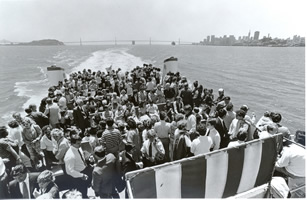 Lunch for the Office Bunch - a spring, summer & fall favorite!
Lunch for the Office Bunch - a spring, summer & fall favorite!
December 24, 1984: The G.T. San Francisco returned to service on the Larkspur route, redesignated as the M.S. (Motor Ship) San Francisco.
January 2, 1985: The G.T. Marin left Larkspur bound for San Diego to undergo conversion to diesel propulsion.
May 26, 1985: The G.T. Marin was delivered back to the Bay Area and returned to service the next week.
June 1985: The G.T. Sonoma departed for San Diego for conversion to diesel. Larkspur Ferry resumes year-round midday and weekend ferry service using the remaining two ferry vessels.
Sunday, November 17, 1985: The three Spaulding vessel - the M.S. San Francisco, M.S. Marin, M.S. Sonoma) - were rechristened with their new Motor Ship (M.S.) designation after undergoing engine conversion from gas turbine to diesel propulsion.
Monday, November 18, 1985: The frequency of Larkspur Ferry service increased by putting all three Spaulding Class vessels into service for the first time. Previously, one vessel was always in standby to back up the other two. By the following year, ridership increased over 10%.
March 1986: A covered passenger waiting area was added within the existing “space frame” structure at Larkspur Ferry Terminal.
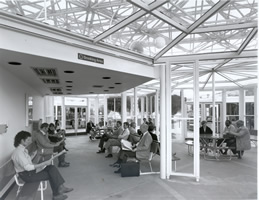 Covered waiting area added for passengers
Covered waiting area added for passengers
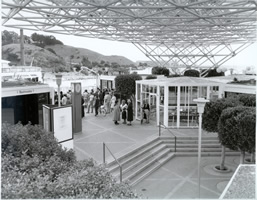 Larkspur Terminal's "space" frame
Larkspur Terminal's "space" frame
Thursday, December 11, 1986: Larkspur Ferry celebrated its 10th anniversary. Three commuters were selected to serve as honorary captain, first mate, and deckhand on several evening commute trips. Commemorative plates, cast from surplus aluminum used to build the Spauldings and etched with the design of the G.T. San Francisco, were given away.
September 20, 1989: Passenger Tara Figone was named the 10 millionth Larkspur Ferry rider since service started in 1976.
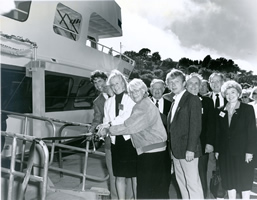 Celebrating Golden Gate Ferry's 20th anniversary in 1990
Celebrating Golden Gate Ferry's 20th anniversary in 1990
May 1992: Larkspur Ferry added early morning service for the annual Bay to Breakers footrace in San Francisco, which starts just a few blocks from the terminal.
June 1994: Work on a fourth berth at the Larkspur Ferry Terminal was completed.
July 1995 through November 1995: An Initial Study and Environmental Assessment for the acquisition of a new ferry vessel and the expansion of Larkspur Ferry service was circulated for public and agency comment. A negative declaration was adopted by the District Board of Directors.
March 28, 1997: The name Motor Vessel (M.V.) Del Norte was approved by the Board of Directors to adorn the Golden Gate Ferry's first high-speed catamaran.
October 30, 1997: The M.V. Del Norte was christened in Anacortes, WA.
July 3, 1998: Golden Gate Ferry started a six-month trial of Friday-only, late-night ferry service with one trip from San Francisco to Larkspur at 11:15 p.m. Due to low ridership, the trial was suspended less than six months later.
July 22, 1998: The M.V. Del Norte departed Anacortes, WA destined for Larkspur, CA. The vessel made a stop in Crescent City, CA the next day for welcoming and christening ceremonies in her namesake County of Del Norte on the way to Larkspur, CA.
July 25, 1998: The M.V. Del Norte sailed under the Golden Gate Bridge and entered the San Francisco Bay.
Friday, August 28, 1998: Two welcoming ceremonies are held for the M.V. Del Norte – at the Larkspur Ferry Terminal and at the San Francisco Ferry Terminal.
Tuesday, September 8, 1998: Golden Gate Larkspur Ferry expanded service between San Francisco and Larkspur with the launch of the new 390-passenger high-speed M.V. Del Norte. Customers now had more options, including more frequent trips, better departure times, and faster crossings.
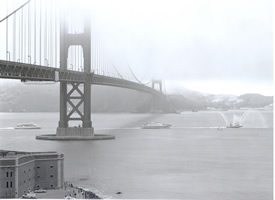 The M.V. Del Norte arrives in the San Francisco Bay
The M.V. Del Norte arrives in the San Francisco Bay
Thursday, March 31, 2000: Direct service to the San Francisco Giants baseball stadium in San Francisco began.
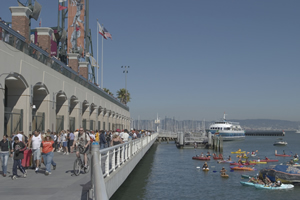 The Giants Ferry - just steps from the ballpark!
The Giants Ferry - just steps from the ballpark!
April 14, 2000: A contract was awarded to Nichols Bros. Boat Builders, Inc., Freeland, WA to construct a second high-speed catamaran.
Friday, July 20, 2001: Golden Gate Ferry’s second high-speed catamaran, the 450-passenger M.V. Mendocino, stopped at Noyo Harbor, Fort Bragg, CA, in her namesake County of Mendocino, where christening ceremonies were held.
July 22, 2001: The M.V. Mendocino arrived into the San Francisco Bay as she sailed the Golden Gate Bridge.
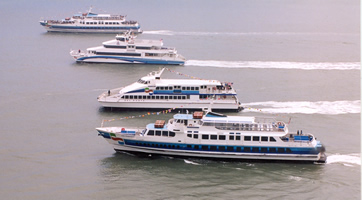 Escorting the M.V. Mendocino
Escorting the M.V. Mendocino
Friday, August 24, 2001: The M.V. Mendocino was christened again at the San Francisco Ferry Terminal and a welcoming ceremony was held later in the day at the Larkspur Ferry Terminal.
The San Francisco Ferry Terminal was rededicated as the Stephan C. Leonoudakis San Francisco Ferry Terminal in honor of a retired District Board member. Leonoudakis was appointed to the Board of Directors in 1962 and was a key leader in the development of ferry service in the early 1970s.
Monday, September 10, 2001: The M.V. Mendocino was placed into service between Larkspur and San Francisco. With two high-speed catamarans, the Larkspur route now offered 41 weekday crossings, up from 26.
2001 and 2002: All three Spaulding Class vessels were repowered with new more modern and efficient diesel engines.
2002: San Francisco History Association bestowed the Ron Ross Founder’s Award to the Golden Gate Ferry Division for the operation of the annual 1906 Earthquake and Fire survivors commemorative ferry rides.
December 2002 to December 2003: To ensure its long-term viability as substantial warranty work was required, the M.V. Mendocino was taken out of service and sent back to the original builder to make necessary repairs at no cost to the District. It had been determined that the aluminum used for the hull was constructed using a process that did not meet stringent marine engineering and U.S. Coast Guard regulations.
March 26, 2004: The original Golden Gate Sausalito Ferry vessel, the M.V. Golden Gate, was retired from the fleet.
July 2004: Larkspur Ferry service was reconfigured so that all trips (with the exception of one afternoon trip) were served by a high-speed catamaran. This allowed Golden Gate Ferry to reduce operating costs.
October 27, 2006: A $6.2 million contract was awarded to Bay Ship & Yacht Company in Alameda, CA, for the refurbishment of the interior of the M.S. Marin.
November 2006 to July 2007: The M.S. Marin underwent an extensive refurbishment, including new seating, paint, deck covering, carpeting, ceiling and wall paneling, lighting, public address system, restrooms, refreshment stands, security cameras, windows, bicycle racks, and modern handicap lift. New generator and electrical systems were also installed.
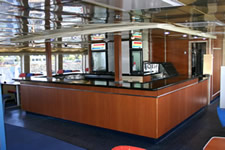 The M.S. Marin's new snack bar
The M.S. Marin's new snack bar
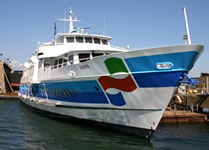 The refurbished M.S. Marin
The refurbished M.S. Marin
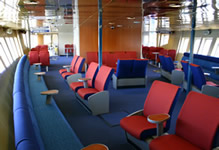 Friendly passenger seating
Friendly passenger seating
June 27, 2008: A $1.3 million construction contract was awarded to Ghilotti Bros., Inc. to reconfigure the Larkspur Ferry Terminal parking lot to accommodate 1,808 parking spaces. In addition, to improve access to the terminal for cyclists, a new bicycle bridge was installed at the terminal entrance. Additionally, improvements were made to the bike/pedestrian path and existing bicycle racks were replaced with new ones. The improvements also included new perimeter signage, new in-roadway lighting systems at two crosswalks, installation of new benches at two viewing areas, and installation of traffic slowing speed bumps at four locations. Construction was completed in May 2009.
October 10, 2008: The Board of Directors authorized the elimination of the Golden Gate Ferry “Frequent Ferry Rider” discount ticket books, effective December 31, 2008, and approved the transition to the Clipper smartcard fare payment as the sole means for receiving frequent rider discounts aboard Golden Gate Ferry.
October 22, 2008: Golden Gate Ferry hosted an interagency rescue drill in coordination with United States Coast Guard Sector San Francisco which took place off the shore of Paradise Cay near Corte Madera, CA. The drill was designed to test the Bay Area Vessel Mutual Assistance Plan including agency emergency evacuation capabilities and mass rescue operations, as well as the ferry system transportation infrastructure. The exercise allowed participants the opportunity to test interagency coordination, communications, and planning effectiveness, and strengthen agency partnerships that are invaluable in maintaining a highly effective safety and security posture within the San Francisco Bay Area. Over 150 California Maritime Academy students played the role of passengers as emergency responders simulated response efforts. Exercise participants also included Marin County Sherriff’s Department, National Park Service, and marine units from Alameda, Contra Costa, and Marin counties. The fire departments from Larkspur, Tiburon, Novato, Ross Valley, and Southern Marin also participated.
January 2009: Golden Gate Ferry purchased two Washington State Ferry vessels, the M.V. Snohomish and the M.V. Chinook, for $2.2 million each. These vessels were built in the late 1990s and were in service for three years, but had been inactive since September 2003. Using predominantly grant funding, both vessels underwent a complete refurbishment to provide “like-new” vessels at an estimated cost of nearly $10 million each.
May 11, 2009: The first of the two vessels purchased from Washington State Ferry, the M.V. Snohomish, arrived in Larkspur.
May 28, 2009: The M.V. Snohomish entered into service on the Larkspur-San Francisco route to provide customers continuity with reliable high-speed catamaran service during the extensive repowering of the M.V. Del Norte.
June 1, 2009: In a unique partnership, Golden Gate Ferry and Marin Sanitary Service (MSS) unveiled a new onboard recycling program.
June 10, 2009: The M.V. Snohomish was renamed as the M.V. Napa at a ceremony on the Napa River in Napa County.
March 26, 2010: The District Board of Directors authorized the M.V. Chinook, one of two Washington State Ferry vessels purchased by Golden Gate Ferry in January 2009, be officially renamed the M.V. Golden Gate following its refurbishment.
April 2010 to March 2011: The M.V. Golden Gate underwent rehabilitation in Washington State.
October 8, 2010: After the return of the M.V. Del Norte to service, the M.V. Napa was taken out of service to undergo refurbishment.
March 29, 2011: The fully refurbished M.V. Golden Gate was delivered to Larkspur.
April 28, 2011: Golden Gate Ferry hosted a “closed” multi-agency emergency response/security drill on the San Francisco Bay using one of its high-capacity Spaulding vessels in a scenario involving an unidentified explosive device.
June 10, 2011: The M.V. Chinook was officially renamed as the M.V. Golden Gate at a ceremony at the Larkspur Ferry Terminal.
July 8, 2011: This was the last day of full-time operation of the Golden Gate Ferry ticket sales windows at the Larkspur and San Francisco Ferry Terminals. Ticket vending machines were now fully operational at these locations.
Late 2011: The M.V. Napa is due back in Larkspur after having undergone a complete refurbishment.
September 7, 2012: An advertising policy for bus and ferry transit facilities was adopted by the District Board of Directors. The policy provides for commercial advertising only along with proprietary advertising that promotes the District’s own services. All advertising involving religion or politics, as well as advertising that depicts anything violent, illegal, obscene, or defamatory, is excluded.
October 26, 2012: The District Board of Directors authorized the establishment of a capital project to purchase and install two new Tier 2 marine generators on the Golden Gate Ferry Spaulding vessel M.S. Sonoma. The generators were purchased in February 2013 and installed by Admiralty Diesel Services, Inc., Mare Island, CA in early June 2013.
October 31, 2012: Bay Area baseball fans welcomed home the World Champion San Francisco Giants team with a special parade and celebration held in San Francisco. Golden Gate Ferry fans made their enthusiasm known—with record-breaking ridership reaching 14,099 for the day, the highest single ridership day on the Golden Gate Larkspur Ferry route!
December 14, 2012: As part of a larger capital project to develop designs and conduct environmental analyses for improvements at Golden Gate Ferry's Larkspur, San Francisco, and Sausalito facilities, the District Board of Directors adopted a Mitigated Negative Declaration environmental document and approved the conceptual design for a new passenger boarding system in Sausalito.
March 22, 2013: A contract was awarded to Salt River Construction Co. in Corte Madera, CA, for the San Francisco Ferry Terminal Gangway and Floats Service Life Extension project. The work included replacement of load-bearing roller assemblies, bushings, and slides; refurbishment of heavy-scored roller tracks; rebuilding and overhaul of hydraulic components; removal, repair, and reapplication of all coatings and other associated refurbishment of the gangways; and replacement of the foam flotation and other associated rehabilitation and repairs on the terminal’s four floating fender structures. The project was completed in fall 2013.
March 22, 2013: A contract was awarded to Johnson Hicks Marine Electronics in Sausalito, CA for the installation of new Automatic Identification System (AIS) on Golden Gate Ferry vessels. The work included the removal of the previous system and installation of the new AIS and the associated auxiliary equipment on each vessel. The AIS systems are U.S. Coast Guard required equipment and the operation of the AIS system is critical in maintaining the vessels in passenger service as required by the Coast Guard. The installation was completed in July 2013.
March 22, 2013: The Board awarded a contract to Valley Power Systems North, Inc., San Leandro, CA for the needed overhaul of the M.V. Mendocino’s four main engines which are MTU 12V4000M60 engines. The engines were due for routine mid-life overhaul and the work was completed in June 2013.
April 5, 2013: To reduce administrative costs, a new online method for purchasing ferry tickets to San Francisco Giants games was implemented at the start of the 2013 season. Ferry tickets are now purchased online directly through the Giants website so that fans can buy their baseball and ferry tickets with one-stop shopping.
April 19, 2013: A project to install new bikes racks at the Larkspur Ferry Terminal and the San Rafael Transit Center was completed. In Larkspur, work included modifications to existing planters in the paid waiting area and installation of new bicycle racks. In San Rafael, in addition to bike racks, the work included installation of map cases, informational kiosks, and signposts.
June 12, 2013: Golden Gate Ferry hosted an interagency emergency response exercise on the San Francisco Bay. The exercise was planned and coordinated by the California Maritime Academy and was attended by two dozen agencies with emergency response duties including the U.S. Coast Guard, Department of Homeland Security, Federal Bureau of Investigation, Marin County Sheriff’s Marine Unit, San Francisco Bay Ferry, Alcatraz Cruises, Blue & Gold Fleet, Larkspur Fire Department, Tiburon Fire Department, Oakland Police and Fire, San Francisco Police and Fire, Richmond Police and Fire, among others. The exercise was designed to test the tactical response to a security-related event occurring in multiple jurisdictions on the San Francisco Bay and concurrently on two ferry vessels. The tested scenario included a mass casualty incident resulting in fire and smoke, as well as passenger injuries. Both law enforcement and mutual aid boarding was also tested. The Regional Incident Command System protocols for vessel related incidents, along with fire and emergency resource response capability for an on-water mass causality incident, were also tested.
June 15, 2013: Resurfacing of the Larkspur Ferry Terminal parking lot was completed. This work, which began in March 2013, included drainage improvements and the numbering of individual parking spaces.
June 27, 2013: A contract was awarded to Marine Group Boat Works, LLC in San Diego, CA, for the refurbishment of the M.S. San Francisco. The refurbishment involved all vessel components with the exception of the original hull and two generators that were replaced as part of an earlier emissions reduction project. The work was funded entirely with grant funds from the Federal Transit Administration and the State of California under the Public Transportation Modernization, Improvement and Service Enhance Account program. This was the second vessel to undergo a complete refurbishment (the M.S. Marin was refurbished several years earlier). The vessel returned to service the following month.
August-October 2013: America's Cup fans from the North Bay rode Golden Gate Ferry and Golden Gate Transit buses to San Francisco to watch the United States bring home the America's Cup. The two waterfront venues—the America's Cup Village at Marina Green and the America's Cup Park at Piers 27 and 29—were the perfect settings to experience this oldest international sporting event.
August 2013: A re-imagined See Something? Say Something! public awareness campaign was rolled out. Posters were created for each of the District's operating divisions as an ongoing enhancement to existing safety and security measures. See Something? Say Something! is a simple reminder to customers to report suspicious or atypical persons or things encountered while traveling on a bus or ferry or across the Bridge. The posters—displayed throughout District facilities, at bus stops and transit terminals, and in various Bridge locations—encourage customers to join District employees as the "eyes and ears" of their transportation environment to aid in maintaining a safe environment for everyone. The campaign won a First Place APTA (Amercian Public Transportation Association) AdWheel Award!
Labor Day Weekend 2013: During the Labor Day 2013 weekend closure of the San Francisco-Oakland Bay Bridge, Golden Gate Ferry added morning, afternoon, and late night service to provide extra capacity for East Bay residents traveling to and from San Francisco. In addition, the Golden Gate Bridge saw a 25% increase in traffic during the four-day closure.
September 2013: A free ferry shuttle to the Larkspur Ferry Terminal—dubbed "The Wave" in beautifully branded buses—was introduced as a 9-month demonstration project to help alleviate a parking shortage at the terminal. Residents of the Ross Valley communities of Fairfax, San Anselmo, Ross, Kentfield, and Greenbrae could leave their cars at home and enjoy a complimentary, hassle-free ride directly to the terminal. The service was made permanent in June 2014, based on strong ridership.
September 2013: A high-speed commute trip was added to the Larkspur Ferry weekday schedule at 7:30 a.m. as a 9-month demonstration project. The trip was made permanent in early 2014, based on strong ridership.
October 2013-January 2015: Golden Gate Larkspur Ferry and the Marin Country Mart teamed up to invite San Francisco residents and visitors to discover first-class shopping, dining, and events located just steps away from the Larkspur Terminal at the Marin Country Mart. Riders were treated to a one-way ride, compliments of Marin Country Mart, and invited to Friday Night Jazz, the weekly Saturday morning farmers market, and the Sunday afternoon food truck and music event. The promotion increased off-peak, reverse-commute, and weekend ferry ridership.
October 2013: Golden Gate Ferry provided two vessels to San Francisco Bay Ferry during the Fall 2013 BART strike and operated between Oakland and San Francisco during the morning and afternoon peak commute periods.
Winter 2013/2014: The M.S. Marin had its engines rebuilt and had new doors installed. The vessel returned to the Sausalito route in March 2014. The M.V. Napa received rebuilt jets, crew room modifications, new TV monitors, and other maintenance and repairs. The vessel returned to Larkspur service in June 2014.
February 2014: A paid parking program was introduced at the Larkspur Ferry Terminal, offering ferry customers the option of purchasing a monthly permit or paying a daily fee when using the lot on weekdays. The new program was designed to help offset general ferry operating expenses.
May 2014: The District rolled out a new campaign aimed at increasing safety awareness among employees and customers. these colorful posters are reminders to stay safe by being alert and aware of their surroundings. Keep each other safe—Together We Are Golden!
February 2, 2015: Larkspur Ferry began operating a 8:40am trip as a 9-month demonstration project as part of its Golden Gate Larkspur Ferry Service Strategic Vision. The trip is being added to relieve overcrowding and overflow from earlier trips and will replace back-up bus service that had been carrying these overflow passengers.
April 19, 2015: The M.V Mendocino left for a San Diego shipyard for a mid-life refurbishment. The vessel, which joined the Golden Gate Ferry fleet in 2001, was outfitted with larger water jets and new gear boxes to improve reliability, and grew by six feet in the stern to accommodate these modifications. Additionally, new interior walls, ceilings, and seats were installed, and a fresh coat of paint was applied to both inside and outside.
July 1, 2015: The eligibility age for youth discount fares on Golden Gate Transit buses and Golden Gate Ferry was changed to ages 5 through 18. This was done as part of a regional Bay Area initiative put forth by the Metropolitan Transportation Commission (MTC) to establish consistent standards for all regional transit agencies.
Fall 2015: Larkspur Ferry added an overflow parking lot on Larkspur Landing Circle following the Marin Airporter's move to Andersen Drive in San Rafael. This lot was repaved and restriped, and added over 300 parking spaces for riders.
December 2015: The M.V. San Francisco returned to service with more a new lower deck configuration (for either seats or bikes), an overhauled wheelhouse with new electronics, a new multi-use elevator, a revamped engine room with an access door to the stern, and large new entryways with two sliding doors each.
January/February 2016: During Super Bowl 50, Golden Gate Ferry added both midday and evening trips to/from Larkspur for the "Super Bowl City" and "NFL Experience" events in downtown San Francisco.
March 6, 2017: For the first time in forty years, Golden Gate Ferry expanded its Marin County service area and began operating weekday commute ferry service between Tiburon and San Francisco.
October 2017: Golden Gate Ferry and District staff participated in a "spill drill" training scenario at the Marin County Emergency Operations Center. The goal of the training was to protect the safety of emergency responders and the general public, while stabilizing the situation. It was a tabletop exercise, in which the participants played their roles while seated and did the work on paper.
December 2017: Golden Gate Ferry performed a major inspection of the Sausalito Ferry Landing. Work included a comprehensive inspection of the steel float and gangway to determine the condition of the landing. Divers inspected around and under the float. The inspections required full- and half-day shutdowns of all ferry operations to/from Sausalito for several days.
May 2018: The M.S. Marin received an upgrade. The vessel underwent a complete engine and exhaust system overhaul to reduce emissions and improve the vessel’s fuel efficiency while allowing mechanics to make faster repairs in the future. These upgrades were part of a California Air Resources Board emissions program and should keep the Marin running clean and smoothly for at least the next 10 years. The vessel returned to service in October 2018.
Labor Day 2018: For the first time in years, Golden Gate Ferry provided direct service between San Francisco and the Sausalito Art Festival. It was truly a team effort, with Bridge ironworkers, painters, and laborers pitching in!
March 2019: Golden Gate Ferry welcomed a new vessel to its fleet - for one year - with the lease of M.V. Millennium from Rhode Island Fast Ferry. This addition will assist in bringing commuters and visitors alike between Marin County and San Francisco while other vessels undergo scheduled maintenance. The Millennium was loaded onto a transport vessel and brought through the Panama Canal.
December 2019: With the completion of a 2.2-mile track extension from its downtown San Rafael station, the Sonoma Marin Area Rail Transit District (SMART) began operating train service to Larkspur, offering a direct connection to San Francisco for North Bay commuters. The new SMART station is a 15-minute walk (1/2 mile) to the Larkspur Ferry Terminal.
January 4, 2020: Golden Gate Larkspur expanded its weekend schedule, offering new trips that connect with arriving and departing SMART trains.
January 17, 2020: The crew of the M.V. Mendocino responded to a distress call regarding a recreational boat adrift on the San Francisco Bay. As the Mendocino approached the boat, the crew called out to see if anyone was onboard. A woman responded, obviously in pain and asking for assistance due to what she described as a broken back. The District Board of Directors recognized the crew for their heroic efforts in rescuing the injured woman and securing her boat.
February 9, 2020: Golden Gate Ferry temporarily suspended all service due to extreme weather and wind conditions.
July 2020: Golden Gate Ferry and Golden Gate Transit joined other Bay Area Transit agencies in the launch of Clipper START - a new pilot program offering up to 50% off single rides on select transit agencies. Eligible Bay Area residents age 19-64 who meet certain income requirements are issued new Clipper cards that automatically apply the discount.
December 13, 2021: Golden Gate Ferry took over service to Angel Island State Park after Blue and Gold Fleet announced in December 2020 its intentions to cease operations to Angel Island. Golden Gate Ferry began seven day a week service to Angel Island from the San Francisco Ferry Terminal.